
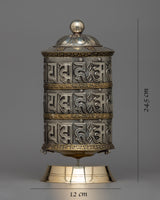
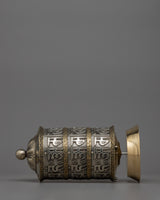
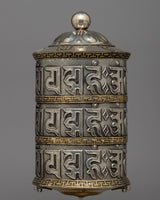
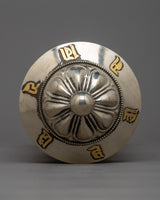

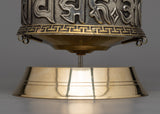
Mantra Prayer Wheel | Spin Your Way to Serenity and Wisdom

100% AUTHENTIC

HANDMADE

FREE SHIPPING
Mantra Prayer Wheel
About our Prayer Wheel
Introducing the Mantra Prayer Wheel, a sacred symbol of spiritual devotion meticulously crafted from white metal. Standing proudly at 24.5cm tall, this exquisite prayer wheel is adorned with three rows of meticulously crafted mantras that exude divine blessings and spiritual resonance.
The prayer wheel's white metal body exudes timeless elegance and a sacred aura thanks to its meticulous craftsmanship. May the mantras inscribed on the wheel resonate deeply within you, invoking peace, serenity, and spiritual enlightenment.
The Mantra Prayer Wheel, whether used as a meditation focal point or as a decorative accent in your sacred space, is an effective tool for spiritual practice and inner transformation. Accept its presence and let its sacred energy guide you on your spiritual path to greater connection and enlightenment.
Introduction to Prayer Wheel
A prayer wheel is a cylindrical wheel on a spindle used in Tibetan Buddhism. It is typically inscribed with the mantra "Om Mani Padme Hum" and rotated by hand as a form of spiritual practice and to accumulate merit. Spinning the wheel is believed to have the same spiritual benefits as verbally reciting the mantra. The use of prayer wheels is widespread in Tibetan Buddhism and has spread to other cultures.
-------------------------------------------
Size: 24.5 cm(Height) x 12 cm(width)
Weight: 0.51 kg
Material: White Metal
-------------------------------------------
How does the Buddhist Prayer Wheel benefit us?
The benefits associated with rotating the wheel are numerous. It promotes knowledge, compassion, and bodhicitta in the practitioner and improves siddhis (spiritual powers such as clairvoyance, precognition, etc.). The practitioner can repeat the mantra as often as possible while the wheel is rolling, maintaining a calm, meditative attitude. A Tibetan Buddhist tradition holds that after a practice session, one should dedicate any acquired merits to the benefit of all sentient beings. Then three times Om Ah Hum. This is usually among Tibetans after finishing any Buddhist practice, including the prayer wheel exercise.

















